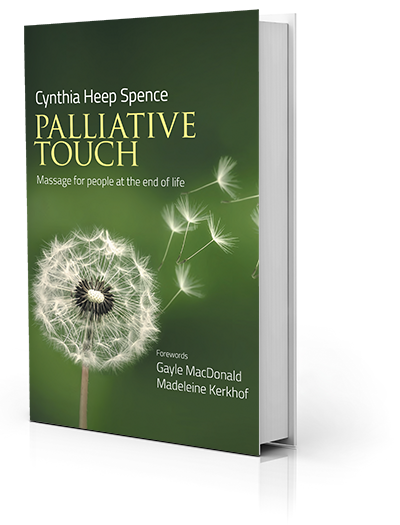Home > Resources > Cynthia Heep Spence | Palliative Touch: Massage for People at the End of Life
Palliative Touch: Massage for People at the End of Life
by Cynthia Heep Spence, Handspring Publishing (2022)
Cindy Spence began her health care career as a Peace Corps volunteer in rural Guatemala, returning to the United States to complete a master’s degree in public health. She has been a massage therapist specializing in palliative care since 1999, after her father-in-law’s dying wish for gentle touch inspired her to attend massage school. Since that time, Cindy has completed more than 6,000 massages for people with advanced and terminal illness. She works at the T. Boone Pickens Center for Hospice and Palliative Care and teaches a 20-hour class on end-of-life massage to health care professionals, including EOL doulas.
Excerpt from chapter 1:
Dual Roles
Some people feel called to more than one helping role and have expanded their knowledge and skills to include a second credential. I know several nurses who have Reiki or massage therapy training, for example. There are massage therapists who pursue training as end-of-life doulas, and doulas who practice massage or energy work. If you are trained in more than one area of expertise, you will likely encounter situations that require you to adhere to one role at a time. A massage therapist with a nursing background would not administer medications or provide medical advice while functioning in the role of massage therapist, for example. But there may also be times when an expanded understanding can be beneficial for a touch therapist.
The story below describes the experience of one licensed massage therapist with doula training who has found a way to embrace her roles as complementary rather than separate.
The Ultimate Couple’s Massage
Massage therapist and end-of-life doula Melanie Eggleston describes her dual expertise as “tightly woven worlds” which are blended in her private practice. The arc of care she is able to provide is beautifully illustrated in her relationship with two clients, Claire and Joseph.
Melanie began providing massage for Claire after Claire was diagnosed with cancer. The two bonded quickly and massage became an integral part of Claire’s treatment and recovery. Years later, while Claire remained a faithful client, Melanie met and began providing massage for Claire’s husband, Joseph, after he too was diagnosed with cancer. Melanie massaged Joseph’s feet during his chemotherapy infusions, which helped him to relax. Despite a year of aggressive treatment, Joseph’s cancer progressed, and he eventually chose hospice care. Melanie’s role then expanded to providing biweekly home sessions for this “wonderful, kind couple.” Melanie’s training as a doula gave her the confidence to accept Claire’s invitation to help her bathe Joseph’s body following his death. Having shared this intimate continuum of life and death with these two special clients, Melanie continues to provide massage for Claire as she grieves the loss of her partner. —EOL doula, LMT Melanie Eggleston
In chapter one, we have laid the groundwork for a common understanding of hospice and palliative care. We considered ways to meet patients where they are on the spectrum of care, whether at home, in a group home, or in an inpatient setting. Each environment has a particular flavor, and some of us will be drawn or more temperamentally suited to one setting compared to another. Regardless of the settings in which we work, we will likely meet other professionals and family members who are important to the patients we serve. Touch therapists have much to offer, and much to receive.

